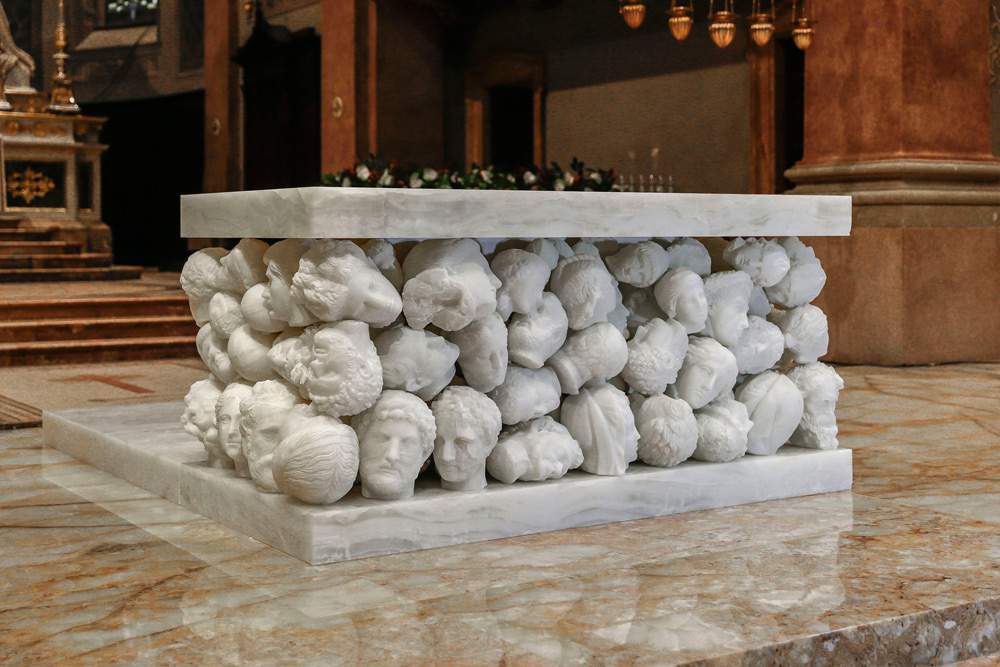Perhaps in Gallarate (Varese) the new altar at the local basilica of Santa Maria Assunta was not expected to go even viral on the web, but it was certainly to be imagined that it would cause discussion. As of Sunday, Nov. 11, the basilica has a new altar, the work of Claudio Parmiggiani (Luzzara, 1943): consecrated in the presence of the archbishop of Milan, Mario Delpini, the altar is made entirely of white onyx and stands out because it is composed of several male and female faces, pagan and Christian, joined by two slabs to make up a sort of parallelepiped all made of heads.
“The faces that make up the altar,” explained episcopal vicar Ivano Valagussa, “are all gathered in unity, the two white slabs unite the people, witnesses to the flow of history; all are called by the will of love to be one in Jesus Christ, his body offered to the Father, the new humanity transfigured by the gift of the Spirit, the true temple of God built with living stones to be the dwelling place of God himself among men. The celebration of the memorial of Easter, the Eucharist, is attraction, convocation, communion, sacrifice for a holiness of life expressed in fraternity, service, charity and evangelical mission. Hence the Church ’from the Gentiles’ and ’outgoing’ is born.” The vicar then associated the basilica’s new Eucharistic table with a number of biblical passages, particularly those dealing with the genealogy of Jesus (gospels of Matthew and Luke) and the prophecy of Nathan (in the second book of the prophet Samuel: in the text, God wants to report to David that a place will be fixed in Israel so that his people “may dwell in his house and no longer be troubled and the unrighteous will not oppress him as in the past”).
Claudio Parmiggiani himself also wanted to offer a reading of his work: “the new Altar for the Basilica of Santa Maria Assunta in Gallarate is summed up in a mensa resulting from the juxtaposition of two luminous marble slabs overlapping each other that hold and protect, almost maternal pelican-like, a multitude of ancient heads; relics and emblems of a sacredness, a humanity, a totality.”
Whatever the message, it should be pointed out that on the web the reception towards the work has not been the best, is Parmiggiani’s work was immediately dubbed “the altar of severed heads,” with many users finding rather macabre or horror tones in the expanse of heads strung one on top of the other, and others who instead interpreted the work (with its heads reminiscent of those of classical art, even with direct quotations: one glimpses there, for example, a portrait of Caracalla, among others) as a kind of allegory of the Church overcoming and destroying the pagans. “Work that leaves one bewildered and astonished,” comments one user, “theologically disturbing” according to another, and then a florilegium of “horrible,” “ugly,” “monstrous,” “frightening,” “truculent,” “in bad taste,” and on and on sinking towards comments that it was felt we should not report. Among the most ironic are those who speculate that the author might be Robespierre, those who imagine that the artist was inspired by the charnel houses found in so many churches, there are those who ask for a chisel, and there are even those to whom the altar reminded them of food images (a piece of nougat, a bag of popcorn, a batch of scamorze). However, there are also those who appreciate it: “I don’t see anything shocking about it,” says one user on Facebook, “just think that in some shrines or ancient churches there are skeletal bodies of saints or bones, or holy relics, under the altar.” Meanwhile, the discussion continues...
Pictured: the altar by Claudio Parmiggiani for the Basilica of Santa Maria Assunta in Gallarate (Varese), photograph by Giorgio Giovara
 |
| Gallarate, the altar "of severed heads" goes viral and makes the web debate |
Warning: the translation into English of the original Italian article was created using automatic tools. We undertake to review all articles, but we do not guarantee the total absence of inaccuracies in the translation due to the program. You can find the original by clicking on the ITA button. If you find any mistake,please contact us.